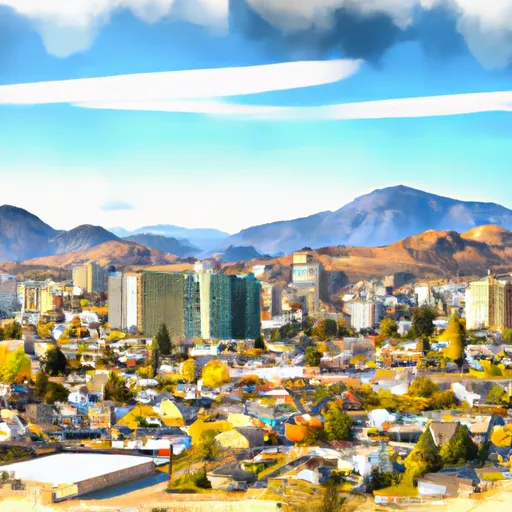-
 Snoflo Premium
Snoflo Premium
Get unlimited access to all our content
With no Ad interruptions! - Start Your Free Trial Login with existing account
Wenatchee
Eden Index
Climate
7.1
•
Recreation
4.1
•
Community
2.8
•
Safeguard
5.0/10

Wenatchee, Washington, is a vibrant city located in the heart of the state. Situated in the eastern part of the Cascade Range, Wenatchee experiences a semi-arid climate with hot summers and cold winters. Summers are typically dry, with temperatures averaging in the mid-80s to low 90s Fahrenheit, while winters can be cold and snowy, with temperatures dropping below freezing.
The city is defined by its proximity to the Columbia River and the Wenatchee River, making it a hub for hydrology constituents. The Columbia River provides water for irrigation, hydroelectric power generation, and recreational activities such as boating and fishing. The Wenatchee River, known for its scenic beauty, offers rafting and kayaking opportunities.
Outdoor enthusiasts will find a wide range of recreational activities in Wenatchee. The surrounding area boasts numerous hiking trails, including the popular Apple Capital Loop Trail that offers stunning views of the river and the city. Wenatchee National Forest is nearby, providing opportunities for camping, fishing, hunting, and wildlife viewing. Winter sports enthusiasts can enjoy skiing, snowboarding, and snowshoeing at nearby Mission Ridge Ski Resort.
With its diverse climate, water resources, and abundant outdoor recreation opportunities, Wenatchee offers an ideal location for those seeking an active and adventurous lifestyle.
What is the Eden Index?
The Snoflo Eden Index serves as a comprehensive rating system for regions, evaluating their desirability through a holistic assessment of climate health, outdoor recreation opportunities, and natural disaster risk, acknowledging the profound impact of these factors on livability and well-being.
Climate Health Indicator (CHI): 7.1
Wenatchee receives approximately
234mm of rain per year,
with humidity levels near 86%
and air temperatures averaging around
11°C.
Wenatchee has a plant hardyness factor of
7, meaning
plants and agriculture in this region tend to thrive during the non-winter months.
By considering the ideal temperature range, reliable water supplies, clean air, and stable seasonal rain or snowpacks, the Climate Health Indicator (CHI) underscores the significance of a healthy climate as the foundation for quality living.
A healthy climate is paramount for ensuring a high quality of life and livability in a region, fostering both physical well-being and environmental harmony. This can be characterized by ideal temperatures, reliable access to water supplies, clean air, and consistent seasonal rain or snowpacks.
Weather Forecast
Streamflow Conditions
Upper Columbia
Area Rivers
Upper Columbia
Snowpack Depths
Upper Columbia
Reservoir Storage Capacity
Upper Columbia
Groundwater Levels
Recreational Opportunity Index (ROI): 4.1
The Recreational Opportunity Index (ROI) recognizes the value of outdoor recreational options, such as parks, hiking trails, camping sites, and fishing spots, while acknowledging that climate plays a pivotal role in ensuring the comfort and consistency of these experiences.
Access to outdoor recreational opportunities, encompassing activities such as parks, hiking, camping, and fishing, is crucial for overall well-being, and the climate plays a pivotal role in enabling and enhancing these experiences, ensuring that individuals can engage in nature-based activities comfortably and consistently.
Camping Areas
| Campground | Campsites | Reservations | Toilets | Showers | Elevation |
|---|---|---|---|---|---|
| Entiat City Park | None | 723 ft | |||
| Wenatchee Confluence State Park | 60 | 623 ft | |||
| Lincoln Rock State Park | 94 | 732 ft | |||
| Wenatchee River County Park | None | 692 ft | |||
| Daroga State Park | 35 | 761 ft |
Nearby Ski Areas
Catastrophe Safeguard Index (CSI):
The Catastrophe Safeguard Index (CSI) recognizes that natural disaster risk, encompassing floods, fires, hurricanes, and tornadoes, can drastically affect safety and the overall appeal of an area.
The level of natural disaster risk in a region significantly affects safety and the overall livability, with climate change amplifying these risks by potentially increasing the frequency and intensity of events like floods, fires, hurricanes, and tornadoes, thereby posing substantial challenges to community resilience and well-being.
Community Resilience Indicator (CRI): 2.8
The Community Resilience Indicator (CRI) recognizes that education, healthcare, and socioeconomics are crucial to the well-being of a region. The CRI acknowledges the profound impact of these elements on residents' overall quality of life. By evaluating educational resources, healthcare accessibility, and economic inclusivity, the index captures the essential aspects that contribute to a thriving community, fostering resident satisfaction, equity, and social cohesion.

